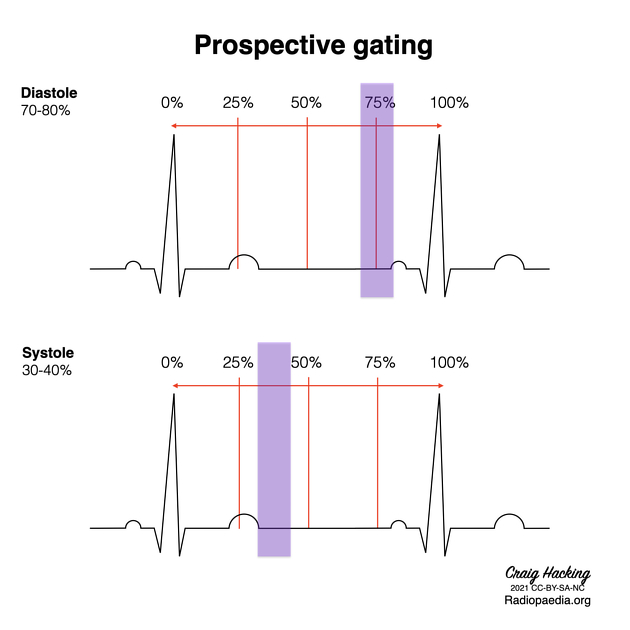Cardiac gating or ECG gated angiography in CT is an acquisition technique that triggers a scan during a specific portion of the cardiac cycle. Often this technique is conveyed to obtain high-quality scans void of pulsation artifact.
On this page:
Technique
Via the attachment of ECG leads, cardiac gating aims to find a consistent portion of the R-R interval (measured as a percentage), most commonly at the mid to end-diastolic phase (around 70% of the R-R interval) 1, where movement is at its least.
For higher heart rates (>80bpm) end-systole acquisition (30-35% of R-R interval, or 350ms) 2 is often utilized.
Gated protocols in cardiac CT
There are a number of different protocols based on the patient presentation that can be broken into prospective and retrospective based:
-
prospective
-
stable sinus rhythm and a heart rate of fewer than 60 beats a minute
-
stable sinus rhythm and a heart rate of fewer than 70 beats a minute
-
-
retrospective
-
atrial fibrillation/arrhythmia
-
Prospectively ECG-gated cCTA protocols
Prospective protocols mean a predetermined portion of the R-R interval is selected for scanning. It is not a functional study, however useful to reduce motion artifact.
Prospective ECG gated (step and shoot)
This technique (also called step-and-shoot mode) is based on the principle that several images acquired at different heart phases and anatomic regions of the heart can be combined for reconstruction of the whole heart.
High-pitch spiral acquisition
Dual-source CT scanners allow for a gapless acquisition with a pitch of up to 3.4 which cannot be achieved with conventional single-source CT scanners. A high-pitch spiral acquisition can be performed in less than one second and thus information from a single heartbeat can be generated. In combination with iterative reconstruction techniques, high-pitch spiral acquisition allows for cardiac CT with sub-milliSievert doses.
Limitations of prospectively ECG-gated protocols
It should be noted that all prospectively ECG-gated protocols are more susceptible to deterioration of image quality due to motion artifacts. Therefore, when choosing such a protocol, the patient's heart rate should ideally be below 65 beats per minute (bpm). In high-pitch spiral acquisition, the heart rate should even be below 60 bpm. Therefore, the cost of significant dose reduction is the limited patient population that such protocols can be applied to.
Retrospectively ECG-gated cCTA protocols
A retrospective protocol means after detection of the heart rhythm, the scan covers the whole heart during multiple cardiac cycles.
This is an established and robust technique which works as a standard spiral CT acquisition. Therefore, information from different phases of the cardiac cycle is gained and can be used. This is especially useful for cine-sequences which show the heart motion throughout the cardiac cycle. Such cine sequences can only be generated from retrospectively ECG-gated cCTA data.
Although several dose-saving techniques for retrospectively ECG-gated cCTA exist (e.g. tube modulation), these protocols still result in a higher radiation dose than newly introduced prospectively ECG-gated protocols. They do however retain their clinical relevance in patients with arrhythmia and for volumetry and functional analysis.
Specific artery selection
Each artery will suffer from motion artifact at different phases, the following intervals are the best ‘windows’ to prevent movement for different arteries 1
-
40% of R-R interval
-
60-70% of R-R interval
-
50-60% of R-R interval





 Unable to process the form. Check for errors and try again.
Unable to process the form. Check for errors and try again.